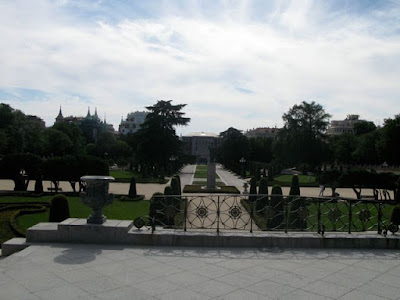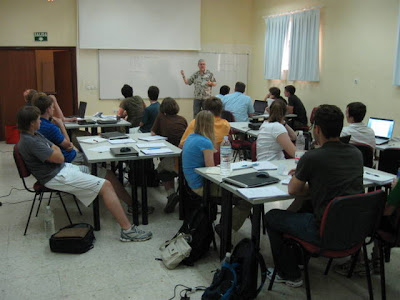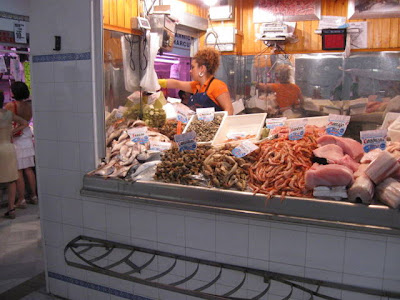After exploring the historical sites in Toledo, our visit to Madrid was all about the Arts and Madrid is a fantastic place for that. The Prado, Reina Sofía, and Thyseen museums are located within approximately a quarter-mile of each other and form what is referred to as the Golden Triangle of Art in Madrid. (note: We were not allowed to take photos in two of the museums so several of the images and some of the background information below were borrowed from the Wikipedia website.)
We started with a tour of the Museo del Prado which was founded 1819 to hold the royal collection of arts. With 1300 works on display, it is considered one of the world's best collections of European art from the 12th to the early 19th century. The building itself was huge and beautiful.

This is the 'Descent of Christ from the Cross,' 1435, by Rogier van der Weyden. This particular painting was striking because of the vibrancy of the colors and the skillfullness of Weyden in creating almost photorealistic images.

These are the La Maja Vestida ("The Clothed Maja") and the La maja Desnuda (The Nude Maja) painted by Francisco Goya in approximately 1800. The Nude Maja was considered quite scandalous at the time.


The Museo Reina Sofía (Queen Sofia Museum), Spain's national museum of 20th century art, was opened in 1992. The addition of Picasso´s "Guernica" to the Reina Sofía collection was a major milestone in the development of what is now considered one of the most important contemporary art museums in the world.
This is Tommy trying to get into the head of Picasso.

The Museo Thyssen-Bornemisza (Thyssen-Bornemisza Museum) fills the historical gaps in the collections of the other two museums. It includes Italian primitives and works from the English, Dutch and German schools. It also has an extensive collection of paintings from European and American Impressionists and Expressionists from the second half of the 20th century.
The collection started in the 1920s as the private collection of Heinrich, Baron Thyssen-Bornemisza de Kászon (1875–1947) and was later expanded by his son Baron Hans Heinrich Thyssen-Bornemisza (1921–2002). In 1985, the Baron married Carmen Cervera (Miss Spain 1961) who was influential in persuading the Baron to locate the collection in Spain. The museum was opened in 1992.
The large installation sculpture behind Stacy was in the entrance courtyard. The students labelled it The Bacon.

Here are representative works from Renoir and Monet.


There was also a temporary exhibit of works by Matisse.

In addition to the major museums and their collections, we visited a small private gallery and enjoyed the public art in the parks.




After 6 days of travel, we board the AVE high speed train for a quick 2 hour trip back to Sevilla.


This was a long and tiring trip. At the end of it, we had two students who were sick with a fever, sore throat, and nausea in one case. Friday, the staff at the Texas Tech Center got them both to the clinic and by Monday they were back to full speed. I can't say enough about the support that we get from the staff here. Thanks Doug, Donna, Mia, and Sara.
For more photos, follow this link: Madrid Photo Album.









































